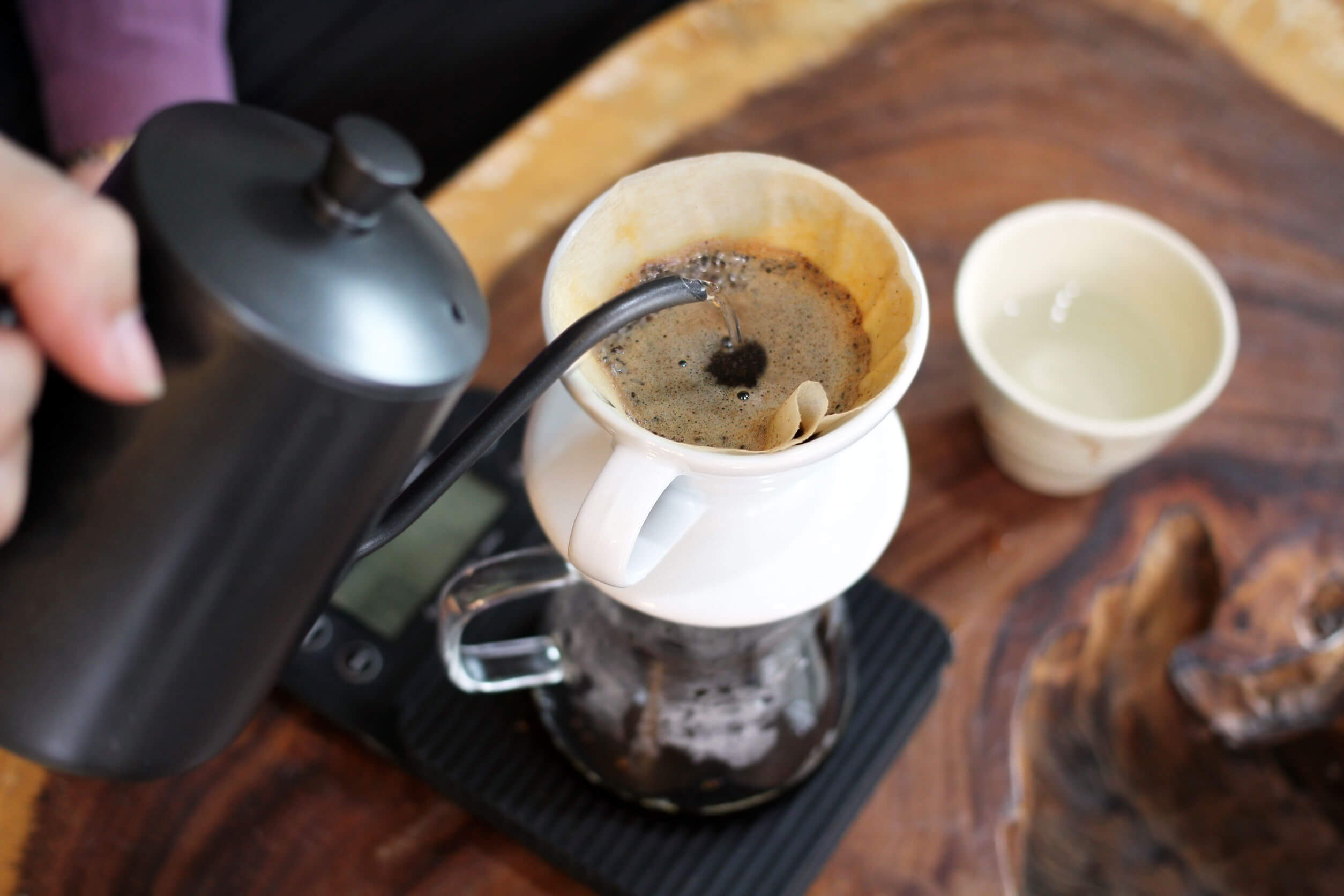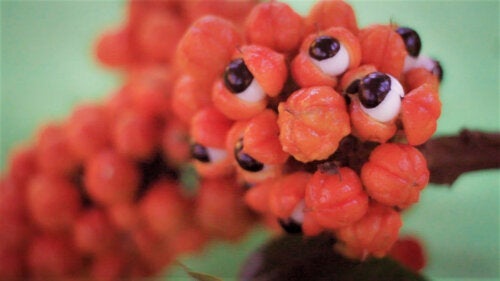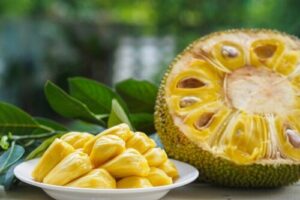학명이 Paullinia cupana인 과라나는 아마존에서 자라는 등반 식물이다. 수세기간 아마존 부족들은 과일과 식물을 다양한 치료 목적으로 사용해 왔다. 과라나 성분 중에서도 특히 카페인, 테오필린, 테오브로민 등 각성제 성분 함량이 높은 것으로 유명하다.
‘Evidence-Based Complementary and Alternative Medicine’에 자세히 설명된 바와 같이 과라나는 신경계, 심장 및 근육의 기능을 향상하는 능력으로 인해 에너지 및 스포츠 음료 제조에 자주 사용된다. 과라나에 관해 좀 더 알고 싶은가?
과라나 용도와 특성
과라나는 길고 유연한 줄기를 가진 식물로 열매가 견과류와 비슷하다. 아마존 지역에서는 원주민들이 과라나로 차나 커피와 비슷한 자극적인 음료를 준비한다. 더 정확하게 말하면 과라나 씨앗은 최대 6%의 카페인을 제공한다.
‘Journal of Ethnopharmacology’은 현재 과라나 생산량의 70%가 에너지 음료 및 청량 음료 산업에 사용된다고 한다. 나머지 30%는 분쇄하여 캡슐 형태로 또는 희석하여 섭취한다.
화장품 성분으로도 활용되는 과라나의 특성은 무엇일까?
더 읽어보기: 매일 과일과 채소를 먹으면 더 오래 산다
과라나 특성: 피로 회복
과라나의 가장 중요한 특성은 높은 카페인 함량이다. ‘Food Research International’에 발표된 기사에 따르면 과라나 씨앗은 커피보다 4~6배 더 많은 카페인을 제공한다.
따라서 활력을 증진하고 피로를 줄일 수 있다. Appetite 저널에 게재된 연구에서 과라나와 함께 비타민 보충제를 섭취한 사람들은 여러 테스트 후 피로감이 덜하다고 보고했다.

체중 감량 지원
과라나 보충제는 체중 감량을 위해 기적적으로 작동하지 않는다.
그러나 건강하고 균형 잡힌 식단 일부로 섭취하면 몇 가지 이점이 있다. 특히, 시험관 연구에 따르면 이 과일은 지방 세포 생성을 돕는 유전자를 억제하는 데 도움이 된다.
또한 풍부한 카페인 함량은 신진대사를 가속하여 휴식 시 칼로리 연소 능력을 향상한다. 더 많은 임상 연구가 필요하지만 그 결과는 유망하다고 본다.
소화기 건강 증진
과라나 화합물은 위장 건강을 위해 자연 의학에서 활용되었다. 더 정확하게 말하면 설사 완하제로 간주한다. 타닌 함량으로 인해 수렴제 역할을 하고 장에서 분비되는 액체의 양을 제한한다.
한편, 카페인 함량은 장 연동 운동을 촉진하여 장과 결장의 수축을 활성화시켜 변비를 진정한다.
눈 건강 관리
과라나의 풍부한 항산화 성분은 눈 건강을 지원한다. 질병 저널에 따르면 이러한 물질은 산화 스트레스 영향을 늦춰 백내장, 녹내장 및 연령 관련 황반 변성 위험을 줄인다.
‘Journal of Functional Foods’ 연구에서 정기적으로 과라나를 섭취한 참가자는 그렇지 않은 참가자에 비해 자가 보고된 시력이 좋았다.
또한 위약과 비교할 때 DNA 손상과 안구 세포 사멸을 줄이는 데 도움이 되었지만 더 많은 임상 연구가 필요하다.
심혈관계 보호
과라나에 함유된 카페인과 카테킨은 심혈관 건강에 긍정적인 영향을 미친다. ‘국제 비타민 및 영양 연구 저널(International Journal for Vitamin and Nutrition Research)’에 발표된 연구에서 이러한 화합물은 항혈소판 응집 특성이 있어 혈전증 및 심장 질환 위험을 감소한다고 발표했다.
결과적으로 ‘Lipids in Health and Disease’에 보고된 바와 같이 과라나는 ‘나쁜’ 콜레스테롤(LDL) 산화를 최대 27%까지 줄일 수 있다.
진통 효과가 있는 과라나
과라나는 다양한 유형의 통증을 완화하는 보조제로 사용한다. 진통 특성은 통증 감각을 담당하는 아데노신 수용체를 차단하는 각성제인 카페인 함량에서 비롯한다.
‘Cochrane Library’에서는 카페인이 진통제의 효과를 크게 향상한다고 자세히 설명한다. 이러한 이유로 과라나는 여러 약물 성분으로 활용된다.
피부 관리
화장품 산업에서 과라나는 카페인, 항산화제, 항균 성분 때문에 크림, 로션, 비누 및 노화 방지 제품을 개선하는 데 자주 사용한다.
‘피부 약리학 및 생리학(Skin Pharmacology and Physiology )’에 보고된 리뷰에 따르면 카페인은 지방 분해를 자극하여 셀룰라이트 감소를 촉진한다. 또한, 자외선(UV)으로부터 진피를 보호하고 노화 과정을 늦춘다.
또 다른 연구에서는 과라나가 높은 항산화 성분 덕분에 노화와 관련된 피부 손상을 크게 감소한다고 자세히 설명한다.
항균 특성
과라나의 항균 특성은 주로 타닌, 카테킨 및 카페인 함량으로 설명된다. Molecules 저널의 연구에서는 이 성분의 추출물이 치태에 존재하는스트렙토코쿠스 무탄 같은 미생물과 싸우는 데 도움이 된다.
이전 연구에서는 설사 및 소화기 질환 증상과 관련된 대장균 과 같은 다른 박테리아에도 작용한다.
항종양
한 연구에서 과라나의 항종양 잠재력이 DNA 손상으로부터 보호하고 암세포 성장을 억제할 수 있음이 관찰됐다. 그러나 이러한 연구는 시험관 및 동물 연구에서 수행되었으므로 여전히 임상 실험이 필요하다.

과라나 부작용과 금기 사항
일반적으로 과라나는 유익한 성분이 많으며 저용량 또는 중간 용량으로 사용하면 독성이 낮다는 사실이 연구로 확인됐다.
그러나 과량 섭취하면 다음과 같은 부작용이 있다.
- 불안
- 불면증
- 경련
- 신경질
- 복통
- 두통
- 심장 박동 변경
게다가 카페인은 의존성을 유발할 수 있다. 또한, 유산이나 태아 기형 위험이 있으므로 임신부는 먹지 않는다.
다음에 해당하는 사람들도 과라나를 먹지 않는 것이 좋다.
- 카페인 알레르기의 병력
- 12세 미만 어린이
- 위십이지장궤양 환자
- 항우울제로 치료 중인 환자
과라나는 건강한 식단이나 의학적 치료를 대체하지 않는다. 이러한 보충제를 복용하기 전에 의사나 전문가와 상담하는 것이 가장 좋다.
더 읽어보기: 변비를 완화하는 과일 스무디 8가지
과라나에 관해 기억할 사항
과라나는 활력을 주며 풍부한 항산화 성분으로 유명하다. 현재 스포츠 또는 에너지 음료 생산에 널리 사용되는 성분이면서 화장품 및 천연 의약품에도 사용한다.
각성제, 특히 카페인 성분 때문에 생산성 향상, 기분 개선 및 질병 위험 감소와 관련이 있다. 그렇더라도 적당히 먹어야 하며 가급적 전문가와 상의하는 것이 안전하다.
참고 문헌
모든 인용된 출처는 품질, 신뢰성, 관련성 및 유효성을 보장하기 위해 저희 팀이 철저히 검토했습니다. 이 글의 참고 문헌은 신뢰할 수 있으며 학문적 또는 과학적 정확성을 갖춘 것으로 간주되었습니다.
- Biblioteca Nacional de Medicina de Estados Unidos. (28 de agosto de 2023). Guaraná. Medlineplus. Consultado el 20 de octubre de 2023. https://medlineplus.gov/spanish/druginfo/natural/935.html#Dosage
- Bonadiman, B. S. R., Cadoná, F. C., Assmann, C. E., Weis, G. C. C., de Oliveira Alves, A., Frescura Duarte, M., Chaves, C. M., do Carmo Chaves, C., dos Santos Motta, K. M., Esteves Ribeiro, E., Dulce Bagatini, M., & Mânica da Cruz, I. B. (2017). Guarana (Paullinia cupana): cytoprotective effects on age-related eye disfuntion. Journal of Functional Foods. 36: 375-386. https://www.sciencedirect.com/science/article/abs/pii/S1756464617304152
- Canadian Academy of Sports and Nutrition. (s.f.). Guarana. Consultado el 19 de octubre de 2023. https://www.caasn.com/guarana.html
- D’Angelo, S., & Ascione, A. (2020). Guarana and physical performance: a myth or reality? Journal of Human Sport and Exercise, 15(3), 539-551. https://www.researchgate.net/publication/344832416_Guarana_and_physical_performance_A_myth_or_reality
- Derry, C. J., Derry. S., & Moore, R. A. (2012). Caffeine as an analgesic adjuvant for acute pain in adults. Cochrane Database Systematic Reviews. 14 (3): CD009281. https://pubmed.ncbi.nlm.nih.gov/22419343/
- De Lima, Portella, R., Pillon Barcelona, R., Flores da Rosa, E, Esteves Ribeiro, E., Mânica da Cruz, I. B., Suleiman, L., & Antunes Soares, F. A. (2013). Guaraná (Paullinia cupana Kunth) effects on LDL oxidation in elderly people: an in vitro and in vivo study. Lipids in Health and Disease. 12,12. https://lipidworld.biomedcentral.com/articles/10.1186/1476-511X-12-12
- Da Silva, N., Numata E. P., Mendes, L., Dias P. H., Vilegas, W., Gambero, A., & Lima, L. (2017). Modulatory effects of Guarana (Paullinia cupana) on adipogenesis. Nutrients, 9(6) 1-11. https://www.ncbi.nlm.nih.gov/pmc/articles/PMC5490614/
- Patrick, M., Kim, H. A., Oketch-Rabah, H., Marles, R. J., Roe, A. L., & Calderón, A. I. (2019). Safety of guarana seed as a dietary ingredient: A review. Journal of agricultural and food chemistry, 67(41), 11281-11287. https://pubmed.ncbi.nlm.nih.gov/31539257/
- Peixoto, H., Roxo, M., Röhrig, T., Richling, E., Wang, X., & Wink, M. (2017). Anti-Aging and antioxidant potential of Paullinia cupana var. sorbilis: findings in Caenorhabditis elegans indicate a new utilization for roasted seeds of Guarana. Medicines. 4 (3):61. https://pubmed.ncbi.nlm.nih.gov/28930275/
- Pizzino, G., Irrera, N., Cucinotta M., Pallio, G., Mannino, F., Arcoraci, V., Squadrito, F., Altavilla, D., & Bitto, A. (2017). Oxidative stress: harms and benefits for human health. Oxidative Medicine and Cellular Longevity. 2017: 8416763. https://www.ncbi.nlm.nih.gov/pmc/articles/PMC5551541/
- Schimpl, F. C., da Silva, J. F., Gonçalves, J. F. de C., & Mazzafera, P. (2013). Guarana: Revisiting a highly caffeinated plant from the Amazon. Journal of Ethnopharmacology. 150 (1): 14–31. https://www.sciencedirect.com/science/article/abs/pii/S0378874113005771
- Torres E. A., Pinaffi-Langley, A. C., de Souza Figueira, Silva Cordeiro, K., Dias, Negrao, L., Jurema Soares, M., Pereira da Silva, C., Zsigovics Alfino, M. C., Rodrigues Sampaio, G., & Costa de Camargo, A. (2021). Effects of the consumption of guarana on human health: a narrative review. Comprehensive Reviews in Food Science and Food Safety, 21, 272-295. https://ift.onlinelibrary.wiley.com/doi/epdf/10.1111/1541-4337.12862
- Van Schaik L., Kettle, C., Green, R., Irving, H. R., & Rathner, J. A. (2021). Effects of caffeine on brown adipose tissue thermogenesis and metabolic homeostasis: a review. Frontiers in Neuroscience. 15. https://www.frontiersin.org/articles/10.3389/fnins.2021.621356/full
- Smith N, Atroch AL. Guaraná’s Journey from Regional Tonic to Aphrodisiac and Global Energy Drink. Evid Based Complement Alternat Med. 2010 Sep;7(3):279-82. doi: 10.1093/ecam/nem162. Epub 2007 Dec 5. PMID: 18955289; PMCID: PMC2887323.
- da Silva, G. S., Canuto, K. M., Ribeiro, P. R. V., de Brito, E. S., Nascimento, M. M., Zocolo, G. J., Coutinho, J. P., & de Jesus, R. M. (2017). Chemical profiling of guarana seeds ( Paullinia cupana ) from different geographical origins using UPLC-QTOF-MS combined with chemometrics. In Food Research International (Vol. 102, pp. 700–709). Elsevier BV. https://doi.org/10.1016/j.foodres.2017.09.055
- Kennedy DO, Haskell CF, Robertson B, Reay J, Brewster-Maund C, Luedemann J, Maggini S, Ruf M, Zangara A, Scholey AB. Improved cognitive performance and mental fatigue following a multi-vitamin and mineral supplement with added guaraná (Paullinia cupana). Appetite. 2008 Mar-May;50(2-3):506-13. doi: 10.1016/j.appet.2007.10.007. Epub 2007 Oct 30. PMID: 18077056.
- Dulloo AG, Geissler CA, Horton T, Collins A, Miller DS. Normal caffeine consumption: influence on thermogenesis and daily energy expenditure in lean and postobese human volunteers. Am J Clin Nutr. 1989 Jan;49(1):44-50. doi: 10.1093/ajcn/49.1.44. PMID: 2912010.
- de Jesus NZ, de Souza Falcão H, Gomes IF, de Almeida Leite TJ, de Morais Lima GR, Barbosa-Filho JM, Tavares JF, da Silva MS, de Athayde-Filho PF, Batista LM. Tannins, peptic ulcers and related mechanisms. Int J Mol Sci. 2012;13(3):3203-28. doi: 10.3390/ijms13033203. Epub 2012 Mar 8. PMID: 22489149; PMCID: PMC3317710.
- Lohsiriwat S, Kongmuang P, Leelakusolvong S. Effects of caffeine on anorectal manometric findings. Dis Colon Rectum. 2008 Jun;51(6):928-31. doi: 10.1007/s10350-008-9271-y. Epub 2008 Mar 19. PMID: 18350336.
- Braakhuis A, Raman R, Vaghefi E. The Association between Dietary Intake of Antioxidants and Ocular Disease. Diseases. 2017 Jan 30;5(1):3. doi: 10.3390/diseases5010003. PMID: 28933356; PMCID: PMC5456332.
- Bonadiman, B. da S. R., Cadoná, F. C., Assmann, C. E., Weis, G. C. C., de Oliveira Alves, A., Duarte, M. F., Chaves, C. M., do Carmo Chaves, C., dos Santos Motta, K. M., Ribeiro, E. E., Bagatini, M. D., & da Cruz, I. B. M. (2017). Guarana (Paullinia cupana): Cytoprotective effects on age-related eye dysfunction. Journal of Functional Foods, 36, 375-386. https://doi.org/10.1016/j.jff.2017.07.027
- Subbiah MT, Yunker R. Studies on the nature of anti-platelet aggregatory factors in the seeds of the Amazonian Herb Guarana (Paullinia cupana). Int J Vitam Nutr Res. 2008 Mar;78(2):96-101. doi: 10.1024/0300-9831.78.2.96. PMID: 18791978.
- Portella, R.d.L., Barcelos, R.P., da Rosa, E.J.F. et al. Guaraná (Paullinia cupana Kunth) effects on LDL oxidation in elderly people: an in vitro and in vivo study. Lipids Health Dis 12,12 (2013). https://doi.org/10.1186/1476-511X-12-12
- Derry CJ, Derry S, Moore RA. Caffeine as an analgesic adjuvant for acute pain in adults. Cochrane Database Syst Rev. 2012 Mar 14;(3):CD009281. doi: 10.1002/14651858.CD009281.pub2. PMID: 22419343.
-
Herman A, Herman AP. Caffeine’s mechanisms of action and its cosmetic use. Skin Pharmacol Physiol. 2013;26(1):8-14. doi: 10.1159/000343174. Epub 2012 Oct 11. PMID: 23075568.
-
Peixoto H, Roxo M, Röhrig T, Richling E, Wang X, Wink M. Anti-Aging and Antioxidant Potential of Paullinia cupana var. sorbilis: Findings in Caenorhabditis elegans Indicate a New Utilization for Roasted Seeds of Guarana. Medicines (Basel). 2017 Aug 15;4(3):61. doi: 10.3390/medicines4030061. PMID: 28930275; PMCID: PMC5622396.
- Yamaguti-Sasaki E, Ito LA, Canteli VC, Ushirobira TM, Ueda-Nakamura T, Dias Filho BP, Nakamura CV, de Mello JC. Antioxidant capacity and in vitro prevention of dental plaque formation by extracts and condensed tannins of Paullinia cupana. Molecules. 2007 Aug 20;12(8):1950-63. doi: 10.3390/12081950. PMID: 17960098; PMCID: PMC6149164.
- da Fonseca CA, Leal J, Costa SS, Leitão AC. Genotoxic and mutagenic effects of guarana (Paullinia cupana) in prokaryotic organisms. Mutat Res. 1994 May;321(3):165-73. doi: 10.1016/0165-1218(94)90041-8. PMID: 7513067.
- Fukumasu H, Latorre AO, Zaidan-Dagli ML. Paullinia cupana Mart. var. sorbilis, guarana, increases survival of Ehrlich ascites carcinoma (EAC) bearing mice by decreasing cyclin-D1 expression and inducing a G0/G1 cell cycle arrest in EAC cells. Phytother Res. 2011 Jan;25(1):11-6. doi: 10.1002/ptr.3216. PMID: 20564499.
- Fukumasu H, Avanzo JL, Heidor R, Silva TC, Atroch A, Moreno FS, Dagli ML. Protective effects of guarana (Paullinia cupana Mart. var. Sorbilis) against DEN-induced DNA damage on mouse liver. Food Chem Toxicol. 2006 Jun;44(6):862-7. doi: 10.1016/j.fct.2005.11.010. Epub 2006 Jan 9. PMID: 16406177.
-
Fukumasu H, Avanzo JL, Nagamine MK, Barbuto JA, Rao KV, Dagli ML. Paullinia cupana Mart var. sorbilis, guaraná, reduces cell proliferation and increases apoptosis of B16/F10 melanoma lung metastases in mice. Braz J Med Biol Res. 2008 Apr;41(4):305-10. doi: 10.1590/s0100-879×2008000400008. PMID: 18392453.
-
Espinola EB, Dias RF, Mattei R, Carlini EA. Pharmacological activity of Guarana (Paullinia cupana Mart.) in laboratory animals. J Ethnopharmacol. 1997 Feb;55(3):223-9. doi: 10.1016/s0378-8741(96)01506-1. PMID: 9080343.
- Nehlig A. Are we dependent upon coffee and caffeine? A review on human and animal data. Neurosci Biobehav Rev. 1999 Mar;23(4):563-76. doi: 10.1016/s0149-7634(98)00050-5. PMID: 10073894.

